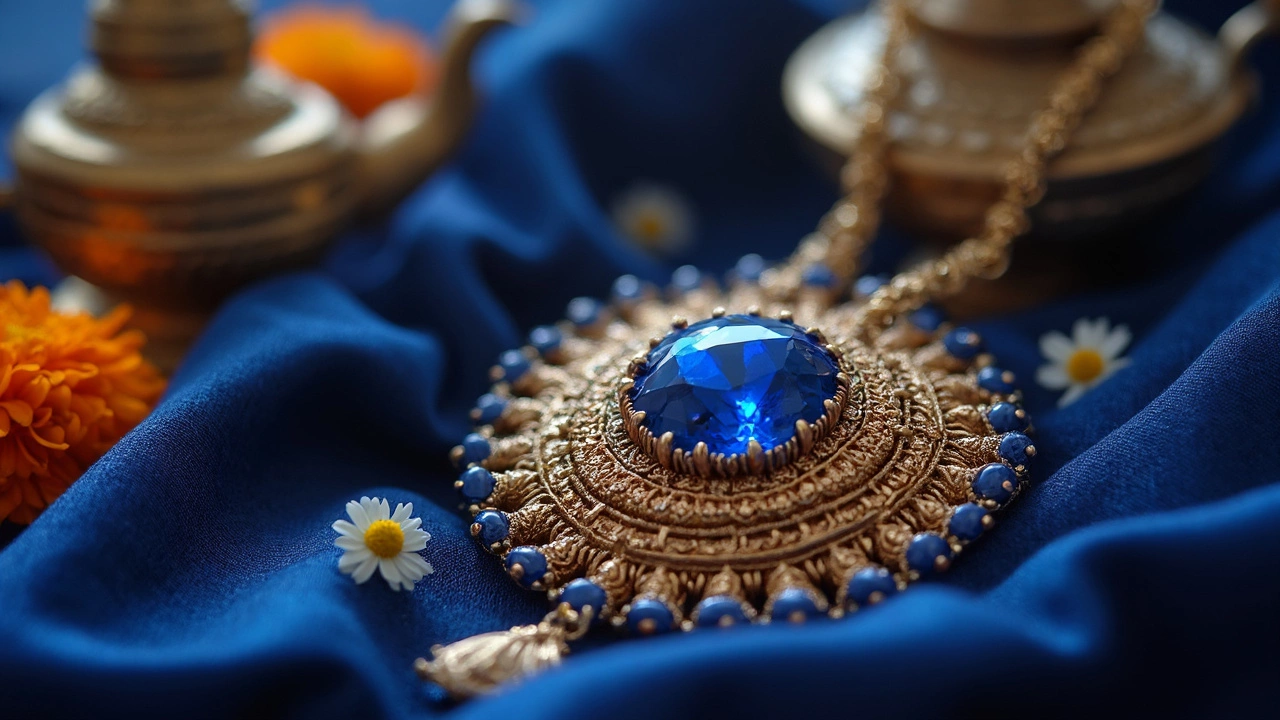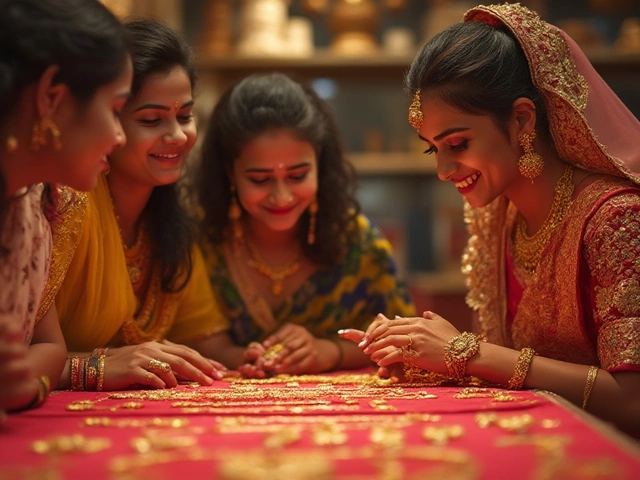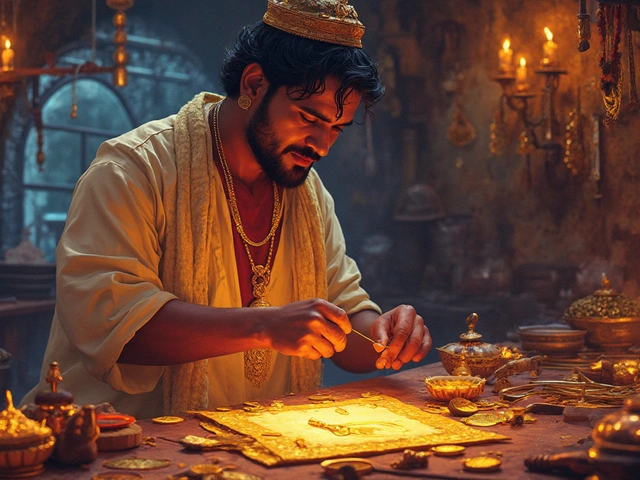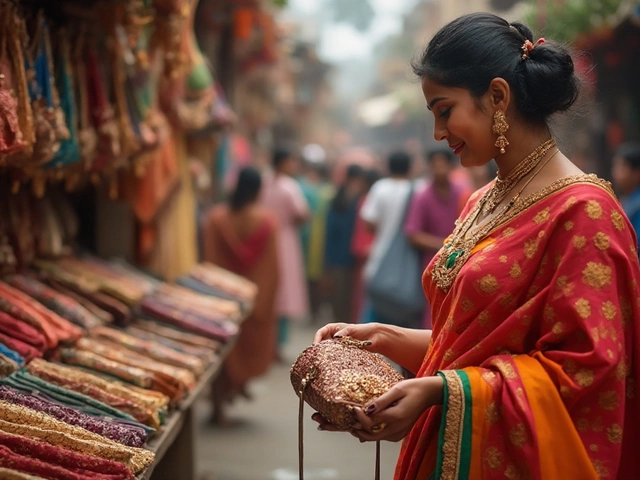Ask any gemstone dealer about the holy grail of blue gems, and you’ll hear two words: Kashmir sapphire. These stones aren't just another type of sapphire — people chase them like they're the Koh-i-Noor of colored gems. But before you start dreaming of adding one to your temple jewellery set, be ready for a shock: they’re nearly impossible to find, especially ones straight from their original source in Northern India.
Here’s what blows most people’s minds: the original Kashmir sapphire mines, high up in the Himalayas, were basically worked out by the early 1900s. Since then, almost all the famous stones you see are either from old royal collections or auctions, not fresh from any mountain mine. That’s why if you ever hear someone claiming to have a new Kashmir sapphire, be extra skeptical. Most on the market today are antiques, recycled, or just mislabelled.
- The Story Behind Kashmir Sapphires
- Why Are They So Rare?
- Spotting a Genuine Kashmir Sapphire
- Impact on Indian Temple Jewellery
The Story Behind Kashmir Sapphires
Back in 1881, a landslide in the little-known region of Kashmir changed the gemstone world forever. Villagers found sparkling blue crystals in the debris—a discovery that led to the most legendary sapphires ever seen. These Kashmir sapphires quickly caught the eye of Indian maharajas and later, European royalty. The British rulers at the time controlled the mines, setting off a sapphire rush like no other. Between 1882 and 1887, most of the top-quality stones you see in museum displays today were pulled from the ground.
The original mine, called Padder or Paddar, was set high in the Himalayan mountains, nearly impossible to reach except for a few months each year. The miners, often working in rough weather, dug out stunning gems with that classic 'cornflower blue' color and a velvety, soft glow—not seen in sapphires from any other place on earth. Word spread fast, and collectors started paying crazy prices for Kashmir stones. Even today, experts say no other region has matched that unique mix of blue color and soft light.
To make things harder for modern hunters, the main mine was exhausted within about a decade. Yes, that’s all it took. After 1900, only small bits and less valuable stones were ever found in nearby areas. So when someone talks about an authentic Kashmir sapphire in temple jewellery or any collection, they’re talking about something truly rare, with a story tied to a particular slice of Indian and gem history.
Why Are They So Rare?
The rarity of Kashmir sapphires isn’t just hype—it’s a perfect storm of geology, history, and a dash of wild luck. For starters, the legendary mine near Zanskar, in the Padar region of Kashmir, was only discovered in 1881 after a landslide exposed a pocket of rich blue crystals. That mine gave up most of its best material in a mad rush that lasted only a few years. By 1887, the main production had already dropped sharply. If you missed that window, you missed the original supply forever.
Unlike other gem sources that run for decades (like Sri Lanka or Madagascar), the Kashmir deposit was tiny. Experts estimate less than 12 kilograms of fine-quality rough were ever pulled out in those glory years. The result? Very few real Kashmir sapphires in the world, and even fewer coming up for sale.
Here's a quick look at how their supply stacks up against other sources:
| Gem Source | Years of Major Mining | High-Quality Sapphires Produced (kg) |
|---|---|---|
| Kashmir, India | 1882-1887 | ~12 |
| Sri Lanka | Ancient-present | Hundreds |
| Madagascar | Late 1990s-present | Hundreds |
So, how does all this play out? If you want a Kashmir sapphire for temple jewellery, be ready to face intense competition from serious collectors and museums. As Dr. Edward Gübelin, a renowned gemologist, once said:
"Kashmir sapphires are the ultimate collector’s gem, not because of their fame, but because of the near-impossibility of finding a genuine stone of good quality today."
Basically, their story is a mix of running out of raw material and huge demand. That’s why their prices can hit record levels at auctions—don't expect the market to relax anytime soon!

Spotting a Genuine Kashmir Sapphire
Figuring out if you’re looking at a real Kashmir sapphire isn’t easy. Plenty of stones out there claim to be from Kashmir, but honestly, most aren’t. The real deal stands out, but you’ve got to know what to watch for.
- Color: The classic Kashmir sapphire is famous for a deep, velvety blue, sometimes called “cornflower blue.” It isn’t just any blue—there’s a soft, almost fuzzy glow that feels different from sapphires out of Sri Lanka or Madagascar.
- Zoning: Kashmir sapphires rarely show sharp color zoning (those obvious lines where the color changes in the stone). Instead, their color is usually super even.
- Silk Inclusions: Inside the stone, if you look under a jeweler’s loupe, you might spot tiny needle-like inclusions—gem folks call this “silk.” In a Kashmir, these are super fine and evenly spread, making the stone’s blue seem kind of dreamy instead of glassy.
- Origin Documentation: A trusted lab certificate—like GIA, SSEF, or Gubelin—is a must for anything high-value. These labs can test for chemical markers in the sapphire, which often proves (or disproves) the Kashmir story.
Here’s a quick table that sums up how Kashmir sapphires stack up against two other popular sources:
| Feature | Kashmir | Sri Lanka | Madagascar |
|---|---|---|---|
| Color | Velvety cornflower blue | Paler, light to deep blue | Bright, clear blue, often darker |
| Inclusions | Fine, silky needles | Less silk, more crystals | Variable, often less visible |
| Availability | Extremely rare | Common | Common |
There’s no home kit to confirm origin—leave that to the labs. A so-called “Kashmir” for cheap is almost always too good to be true. If someone’s offering a bargain sapphire with a wild backstory, it’s smart to walk away or ask for proof. Collectors and jewellers basically rely on that one Kashmir sapphires keyword on a legit lab report—it makes all the difference, both in value and bragging rights.
Impact on Indian Temple Jewellery
If you ask jewellers who deal with temple jewellery across India, most will say they’ve rarely—if ever—worked with a real Kashmir sapphire. That’s how rare these gems are. In fact, most high-value Indian temple jewellery uses rubies, emeralds, and Sri Lankan sapphires instead, simply because Kashmir sapphires are out of reach for most people, both in terms of price and supply.
Back in the late 1800s, when Kashmir sapphires first hit the global scene, a handful made their way into royal Indian temples, especially those with connections to princely families in Hyderabad and Rajasthan. You might spot the odd example in museum pieces or ancient shrines, but for modern temple jewellery, spotting a Kashmir stone is like winning the lottery.
Price-wise, these sapphires command jaw-dropping figures. Some auctions have seen fine specimens fetch up to $200,000 per carat. Here’s a quick look at how that stacks up against other popular stones used in temple jewellery:
| Gemstone | Typical Price Range (per carat) |
|---|---|
| Kashmir Sapphire | $50,000–$200,000+ |
| Sri Lankan (Ceylon) Sapphire | $2,000–$10,000 |
| Ruby (Burmese) | $10,000–$50,000 |
| Emerald | $2,000–$15,000 |
For temple jewellery collectors or anyone trying to get their hands on true antique pieces, here are some practical tips:
- If someone claims to have an original Kashmir sapphire in a temple necklace, ask for old appraisal papers or origins proofs—don’t just take their word for it.
- Look for signs of age and wear. Most true Kashmir stones in Indian temple jewellery will be set in vintage pieces, usually pre-1940.
- If you want the color and look without the price tag, some artisans use old color-matched Sri Lankan sapphires instead, which offer a similar blue but are easier to verify and a lot more affordable.
For my son Devansh, who’s fascinated by old Indian jewellery, I always say: 99% of impressive temple sapphire jewellery you’ll see isn’t Kashmir, but that doesn’t mean it’s not valuable or beautiful. But if you do ever spot the real deal, it’s probably sitting in a museum—or someone’s hidden royal stash.



